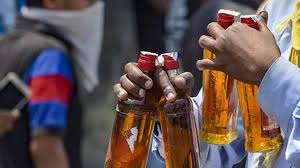
Illicit Liquor and Hooch Tragedies in India: A Deep Dive into the Ongoing Crisis
Illicit Liquor and Hooch Tragedies in India: A Deep Dive into the Ongoing Crisis
The Persistent Threat of Illicit Liquor in India
Illegally brewed liquor, popularly known as hooch, continues to pose a grave challenge to India’s public health and legal machinery. Devoid of any regulatory oversight or quality checks, these alcoholic concoctions are often produced in hidden, unsanitary locations. A common but lethal practice involves adding methanol—an industrial solvent—to increase potency and profitability. For millions belonging to economically disadvantaged sections, hooch remains an accessible alternative to heavily taxed legal alcohol. This toxic brew has led to repeated episodes of mass poisoning, blindness, and fatalities, especially in rural belts and urban slums. The persistence of the problem points to systemic failures, including lenient law enforcement, local complicity, and the absence of a comprehensive alcohol regulation framework in several Indian states.
Methanol: The Industrial Chemical Fueling Fatalities
Methanol is a clear, volatile liquid bearing a strong resemblance to ethanol, the type of alcohol fit for human consumption. However, unlike ethanol, methanol is extremely toxic even in small doses. It is typically synthesized for industrial use in items like paint thinners, windshield washer fluids, adhesives, and antifreeze. Methanol’s high intoxication potential and easy availability make it a common adulterant in illicit liquor production. Once consumed, the body metabolizes it into harmful by-products—formaldehyde and formic acid—which disrupt bodily functions and can lead to multisystem organ failure. Tragically, many victims are unaware of the presence of methanol in the liquor until symptoms set in—by which point it is often too late for effective treatment.
The Human Cost of Methanol Toxicity
The clinical effects of methanol poisoning are both devastating and deceptive. The onset of symptoms is delayed, sometimes by 12 to 24 hours, which often prevents timely medical attention. Early indicators include nausea, vomiting, dizziness, and blurred vision, which can progress to seizures, unconsciousness, and death if untreated. Damage to the optic nerve can cause irreversible blindness—a hallmark of methanol poisoning. The fatal dose is alarmingly small, with as little as 30 ml capable of causing death. Unlike ethanol, which can be metabolized by the liver with limited harm if consumed moderately, methanol has no safe threshold for human consumption. Treatment options include the use of ethanol as a competitive inhibitor, dialysis, and administration of folinic acid—but access to these is limited in rural healthcare settings.
Repeated Tragedies: Gaps in Regulation and Oversight
Despite recurring fatalities, effective enforcement remains elusive. The tragic incident in Amritsar, where over 20 lives were lost to spurious liquor, is not an isolated case but part of a larger pattern. From Gujarat and Bihar to Uttar Pradesh and Tamil Nadu, hooch-related deaths make headlines every year, highlighting institutional apathy. The diversion of industrial methanol—often stored without stringent checks—is poorly monitored. Local excise departments are frequently under-resourced or plagued by corruption, allowing illegal distilleries to flourish. Coordination between various departments—health, law enforcement, excise, and pollution control—is often fragmented, enabling organized rackets to avoid scrutiny.
Underlying Social and Economic Drivers
The hooch problem is deeply rooted in broader socioeconomic realities. For people in dry districts or in regions where licensed liquor is either banned or heavily taxed, illicit brews become the only available source of alcohol. Many among the urban poor or daily wage laborers turn to these toxic alternatives due to addiction and financial hardship. The high price of regulated alcohol, limited de-addiction infrastructure, and minimal public health outreach in marginalized areas perpetuate this cycle. Political complicity, often in the form of turning a blind eye to vote-bank considerations, further entrenches the black-market ecosystem. Moreover, the social stigma around alcoholism hinders open dialogue and preventive interventions at the grassroots level.
The Way Ahead: Comprehensive Measures for Mitigation
Tackling this multifaceted crisis calls for a multi-dimensional, long-term strategy. First, there must be tighter regulation and real-time tracking of industrial methanol through barcoding or blockchain-based systems. Second, state excise laws should be harmonized and updated to include stringent penalties for illicit distillation and methanol misuse. Setting up specialized anti-hooch squads under inter-departmental command can help disrupt supply chains and prevent tragedies. Awareness campaigns must go beyond mere slogans—using culturally sensitive messaging, survivor testimonials, and street theatre in regional languages to drive home the risks. Community-based surveillance, particularly in high-risk areas, can help detect and report illegal brewing. Rehabilitation programs must be scaled up and integrated with employment and skill training to ensure long-term behavioral change among addicts.
Strengthening Forensics, Research, and Data Transparency
A less discussed but crucial area involves strengthening forensic capabilities and data transparency. In many hooch tragedies, delays in toxicological testing hinder not only timely medical response but also legal proceedings. State-run forensic labs must be better equipped and staffed to quickly detect methanol and other toxins. Additionally, there is a glaring lack of a national database that systematically tracks hooch-related deaths, incidents, arrests, and industrial methanol usage. Establishing a centralized monitoring system under the Ministry of Home Affairs or Ministry of Health could bridge this gap. Furthermore, encouraging academic research on patterns of substance abuse, methanol trafficking, and regional brewing cultures could inform smarter policies. Transparent reporting, coupled with community engagement, can turn the tide against the enduring threat of illicit liquor.